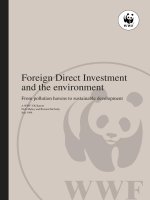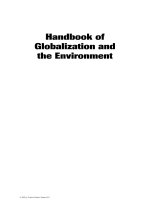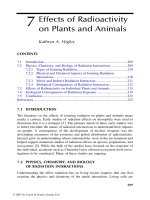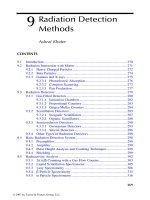economics and the environment
Bạn đang xem bản rút gọn của tài liệu. Xem và tải ngay bản đầy đủ của tài liệu tại đây (1023.49 KB, 37 trang )
ECONOMICS AND
THE ENVIRONMENT
●
●
●
●
How much is clean air worth?
Can you charge somebody for damaging your air?
How much are you willing to pay for clean air?
Should you have to pay for clean air?
●
●
●
●
●
Have you ever caught a fish off the UST pier?
Is cutting down the rainforests efficient?
What market incentives are there for research on the
environment?
How can the environment be priced and sold?
Does Hong Kong have any mechanisms for valuing its
environment?
Lecture Objectives:
● Review
Advantages and Limitations of
Market Economics
● Understand
how economics is creating
new principles and guidelines for
business activity.
Comparing:
●
●
Neo-classical Economics
Environmental Economics
Ecological Economics
●
To reveal policy implications
●
● What
is an economy supposed to
do?
● What
is the Neo-classical
approach?
What is a market?
●A
system of exchange
What is exchanged?
●Resources:
land, labor, capital
(ie. goods or services in some
form)
How does the market
work?
●Matching
demand
of supply and
Why is the market such a good
● Optimal use of resources: buyers force competition
system?
●
on suppliers; greatest return for the efforts of
suppliers
Pareto efficiency: “a situation where it is
impossible to make one person better off without
making anyone else worse off”
– Meaning: allocation of resources to the uses that
will bring the greatest overall increase in
production and monetary value by matching
producers with the highest bidders
What enables the
market to work?
●Price or Value setting
●Profit motive
●Private property
●Government and other
regulating institutions
Does the market operate
perfectly?
1. General Market Failures:
● Monopoly;
● information asymmetry;
● missing markets;
● transaction costs.
Market Failures
●
●
●
●
●
What company did you buy your air from?
How much did you pay for your air? How was that
price set?
How clean was the air you bought? How do you know?
How can a company stop other companies from dirtying
its air? What can you do if someone makes your air
dirty after you bought it?
What rate of return should a company expect to get from
investing in air quality?
2. Environmental Market
Failures:
● Failure to value the environment:
●
●
●
●
●
unpriced use values; option values; existence values;
bequest values
Lack of information
Externalities
Common Access Resources/Sinks
Discounting the future
Missing Markets
Externalities
●
“An unintended cost or benefit of production or
consumption that is not reflected in the price of
the related transactions. Externalities are often
borne by people who are not parties to the
transactions that create them.”
Externalities
●
Define the externalities of your company: who are
the parties to the monetary transaction and who or
what pays for the impacts of the transaction
Discounting the Future
with Net Present Value
(NPV)
NPV = x/(1+.10)nyrs
X + your present money value
.10 = the discount rate
nyrs = the power of how many years down the future
you are looking at
NPV of 100 dollars in five years with a discount rate
of 10% is 100/(1+.10)5 or $62.09
Environmental & Ecological
Economics
1.
2.
3.
4.
Why should CLP pay for pollution controls in
Guangdong rather than in Hong Kong?
Are there any economic tools we can use to value
Hong Kong’s environment?
Are air-conditioned shopping malls reasonable
substitutes for clean air and clean beaches?
What impact would the use of the Mai Po conservation
area for building houses have on Hong Kong’s net
worth?
Cleaner air on horizon by year's end: Liao
Improvements to Guangdong power plants will cut
pollution, says minister
●
Guangdong's biggest cluster of power plants, at Humen in Dongguan which are blamed for much of Hong Kong's air pollution - are being
equipped with desulphurisation devices to cut emissions.
●
In the longer term, Dr Liao hopes a cross-border emission trading
scheme can be set up to assist other power plants in Guangdong to
cut emissions in a more cost-effective manner.
In the meantime, the government has started talks with CLP Power
and Hongkong Electric on emission reduction and an emission trading
scheme.
Hong Kong administration states preference for
system to be used in cross-border emissions trading
…the government says a "cap and trade" method is best for Hong
Kong.
Under this system, the government would set an emissions cap
as well as a timetable for this to be lowered. The capped quantity
of emissions would then be distributed to sources of air pollution,
including power plants and large factories, in the form of emission
allowances or permits.
Polluters who fail to meet the requirements of the cap would have
to buy emissions reduction credits from others who could
successfully lower their emissions below the capped level
Environmental Economics: From
Market Failure to Government Failure
●
●
Limited information of how to deal with specific
environmental problems (of area or industry) and
of firms’ capability to deal with or hide
environmental impact
Limited resources to regulate, monitor and enforce
➥
Command and Control regulations:
uniform standards and technologies
Policy Guidelines from Environmental Economics:
I. Benefits of Using the Market (as
opposed to CAC)
●
●
●
1. Cost effectiveness: example, emission trading
credits
2. Substitution and technological advance:
example, green taxes
3. Other institution/market based schemes: deposit
refund schemes, environmental bonds,
transferable quotas, transfer of development
rights.
Policy Guidelines from Environmental Economics
II. Better Valuation of Nonmarket Valued Assets
●
●
●
●
●
1. Financial Costs
2. Averting Behavior
3. Travel Cost Method
4. Hedonic Pricing
5. Contingent Evaluation
For: Better
Cost-Benefit
Analysis,
regulations,
fines
Environmental Economics and
Ecological Economics
Weak vs. Strong
Sustainability









